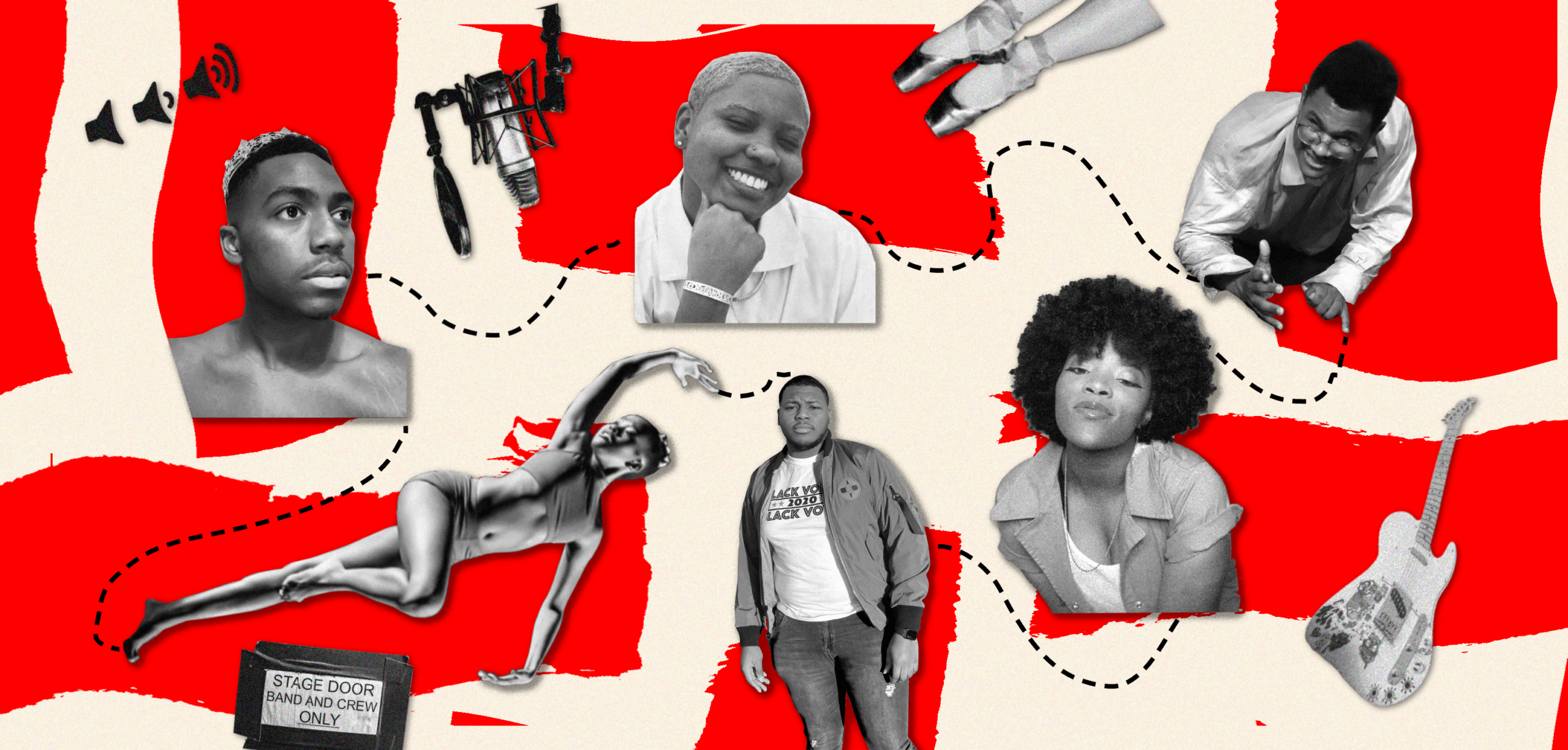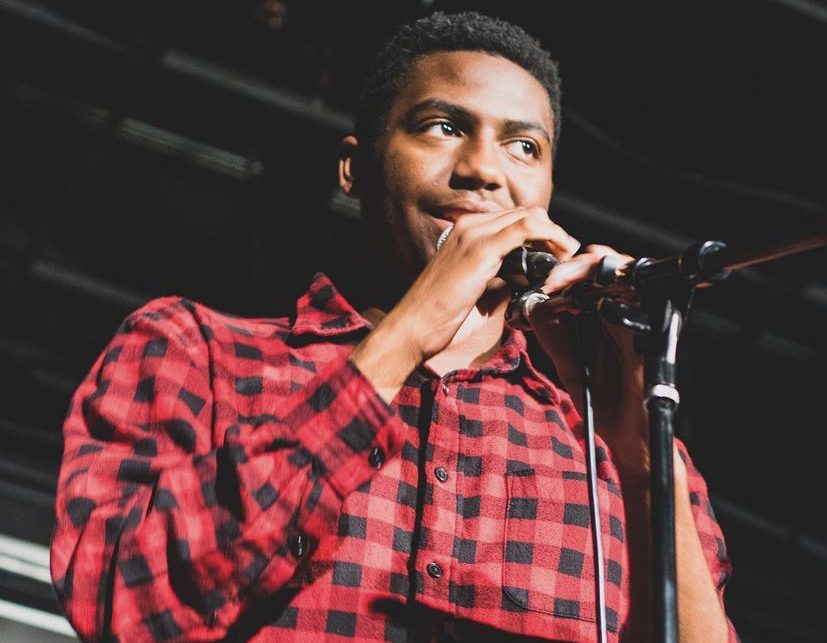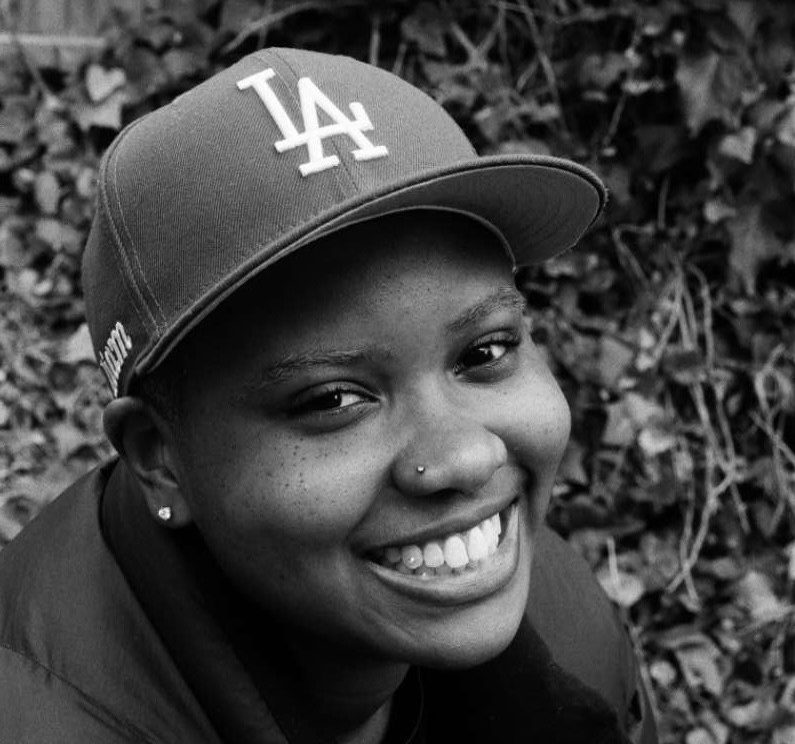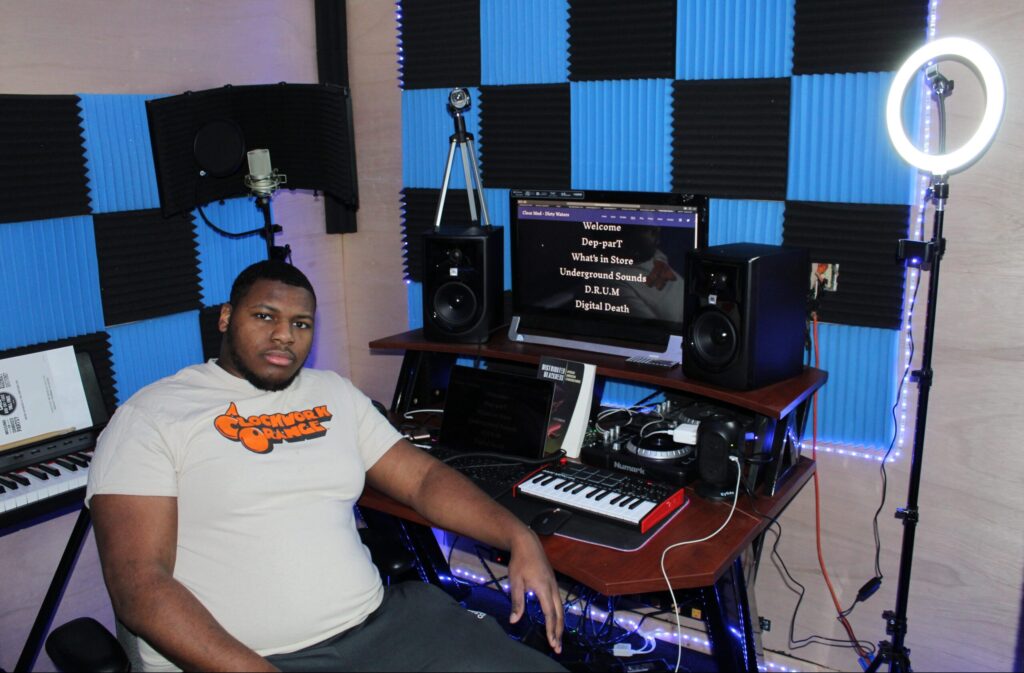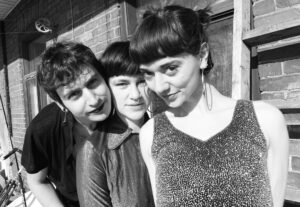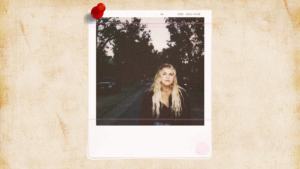To call the present moment in pop culture a ‘renaissance in Black art’ would be a given. On silver screens and through radio-waves, between stanzas, and, yes, in even TikTok shorts, Black artists are and always have been cultural vanguards, even while powerful institutions have failed to pay them proper dues. In a year stocked with violence, loss, and grief, Black art has been a lightning rod for joy and mourning alike.
At Georgetown, too, the Black creative community thrives on, producing vibrant art on a campus much more designed for white consultants than Black artists. As singers, actors, poets, dancers, rappers, writers, or something else entirely, these creatives have created unforgettable, heartful work.
Here are six of them—just a few stars I’ve plucked from a larger galaxy. Glistening, bright, and spirited, they deserve your utmost attention—and university resources for a clearer space of their own.
Kendall Bryant
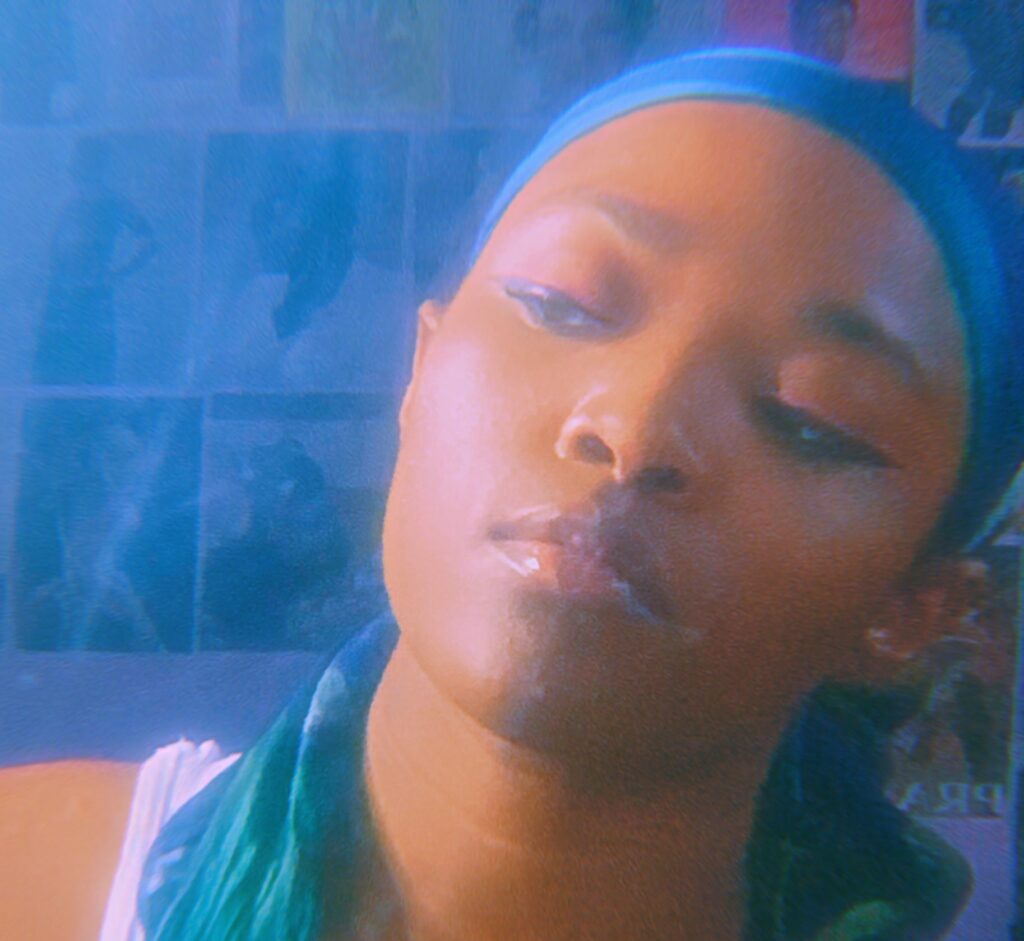 Photo Credit: Kendall Bryant.
Photo Credit: Kendall Bryant.
If the bedroom is the window to the soul, Kendall Bryant’s (MSB’ 23) spirit must be multidimensional: their lavender walls are adorned with hundreds of carefully curated prints of faces and bodies—dark-skinned, light-skinned, ambered, naked, embellished, glamorous. It’s a collage of dizzying beauty and diversity, reflecting a musician’s desire to transcend all genre limitations.
Releasing under the name KENDALL !, Bryant’s music sits at the confluence of R&B, jazz, funk, and soul. Like all good alternative music, the nine songs they’ve released thus far (from “Float” to “The Light” to “Pynk”) seem to defy traditional tropes: downtempo, but not depressed; ethereal, but still present.
“I feel my end goal is to make my own musical language, my own musical symbolism, to paint with my own colors as I make them—to break down what I know and create something completely and uniquely me.” Bryant said. “I want to be known as a genre-less musician and still have people be like, ‘That could be nothing but Kendall.”
It feels fitting, then, to watch Bryant, lip gloss shimmering and white electric guitar (affectionately named “Betty”) in hand, recast rock staples as R&B odes. In a March 7 Twitter clip, they sit beside prints of sunglass-stunting women to record a soulful cover of Radiohead’s “Creep.” Staring straight into camera, they drop the first lyrics so tenderly it almost feels ironic: “I don’t care if it hurts.”
It’s transportive and authentic, so much so that it’s easy to forget the track’s abrasive grunge origins. Bryant transforms one of music’s most covered songs into something it has never been—soulful, but not too heavy. A twilight croon of “I don’t belong here” makes this rendition of “Creep” feel less like a cover and more like a naked reflection of Bryant’s own moment. She yearns perversely for love, but also dreams.
As a queer Black artist, Bryant is emphatic that music is a bit like the escapist “Animal Crossing,” a departure into an utopia and a means to cope with hardship. In the face of an urgent need to dismantle the economic and political systems that oppress Black people, their art is liberating and comforting. “Music has always been my blanket in the coldest days of my life.”
Beyond a source of consolation, Bryant also views Black art as a method of re-imagination through storytelling, even considering it the “architect” to build the ideal world—decolonized and radically free.
“Black art has always shaped Black political reality,” they said. “Black art being the mainstream really does allow for our narrative to come to the front and reshape what people think America is.”
As Kendall creates new music—two EPs are forthcoming, one existential and and the other “pure serotonin”—it is not hard to predict their art will also function to structure new realities. Somatic, emotive, and loving ones.
Will Hammond
 Photo Credit: Will Hammond.
Photo Credit: Will Hammond.
Will Hammond (SFS ’23) is an artist afraid of the word “artist.” When asked about his relationship with the label, he tried to distinguish himself from the “conventional” artist—he’s got an impressive acting CV for a sophomore, and he’s in the Chamber singers, and performance is his primary form of electricity—but “artist”?
It only takes five minutes of watching Hammond bloom on a theater stage (even a digital one) to know he is an artist to the fullest extent of the word. Under the spotlight, Hammond paints: his body the canvas, his brain the brush, and the playwright’s spirit the guiding hand. He terms the acting process an “awakening.”
“You can feel your body giving yourself goosebumps,” he described. “When you’re locked in with someone, it’s like feeling connected—it’s like feeling absolutely grounded to the ground that you are on, and you’re opening up that experience and giving that experience to other people.”
While rehearsing for a short-lived staged reading of the Laramie Project last March, Hammond blew through his multi-character casting with ease. Preacher, father, anonymous homosexual, limousine driver—it didn’t matter. Hammond’s passage in and out of his body is fluent. From playing the titular character in Mask and Bauble’s J.B. to De’Andre in the Black Theatre Ensemble’s (BTE) Blood at the Root, Hammond is precise with each new role. He acts with a radical sense of empathy—an urge to relate to each of his characters at their most vulnerable, to occupy and harness their insecurities as his own.
Though his own character adoption is frictionless, Hammond urges casting directors to be more historically mindful about racial representation. Having grown up in a predominantly white community, Hammond is no stranger to playing historically white characters, experiences that are often more complex than a cast list seems to suggest. In high school, Hammond was assigned a sexually promiscuous, “basically a bully” character in Carrie, and the one knife-adept juror in 12 Angry Men. In a vacuum, these roles are non-controversial—but in an all-white cast, being a Black actor playing the one aggressive or sexualized character can feel distinctly problematic.
“Because I’m Black, it changes the context, it changes what that character really is, and so I guess I have to play into that. But that’s difficult and I don’t know how,” he reflected. “Am I being a stereotypical character? Am I hurting my race by playing this character?”
In Blood at the Root, however, these concerns subsided. In a Black theatre space with a predominantly Black cast and a Black-penned script (writ. Dominique Morriseau), truth emerged for Hammond while playing a football player embroiled in a racist imprisonment scheme.
“I’ve usually had to create my own truth in the theater, or try to draw from other people’s notions I don’t necessarily connect with in a way that is as deep, but I think [this] was the most truthful, aware character that I’ve gotten the opportunity to play,” he said. “I still have the jersey from the character.”
As the associate producer for student theater organization Mask and Bauble, where the bulk of institutional support for theatre is concentrated, Hammond is pushing for the BTE to be given a permanent campus space with sufficient university funding to grow. This way, the BTE can have the resources it requires to deliver the most intentional theatre experiences for audiences and actors alike, ensuring others can be truthseekers, too.
“It’s activist theater in a way, and raises a lot of questions you can talk about for days or weeks afterward,” Hammond said. “It made me feel whole.”
Note: Hammond is a member of the Voice editorial board.
Jalen Arthur
Nothing screams Georgetown more than a dream big enough to scare the shit out of you. So of course, rapper, vocalist, and musician Jalen Arthur (MSB ’21) hopes to one day have a stadium tour—packed arenas à la Taylor Swift and Beyoncé.
“I love performing and really big crowds—and I’d love to do one day do a tour that big and have my music reach people all around the world.”
It’s wildly aspirational, but the Chicago-grown Arthur has the maturing talent and heart to put his career into motion. Influenced by titans Nicki Minaj, Chance the Rapper, and Drake, Arthur’s lyricism is colorful. Showcased in his weekly Instagram “Freestyle Friday” challenge, the range of his references span from Scooby-Doo! to Amy Winehouse’s “Valerie” to (former) Georgetown basketball star Mac McClung.
His body of work is punchy, fresh, spirited—a call-back to an era of hip hop before the lo-fi stylings of Soundcloud took center stage. The cleverness of his lyrics is sure to stir up a crowd; it’s not hard to imagine a thousand bleacher-affixed teenagers yelling, “EY!” collectively at a particularly fluid turn of phrase: “Yo B, put Jalen on it / 5-star and Pentagon-it / I knock ’em, beat unconscious / Acapella, Pentatonix.”
With rap as the new genre king, independent hip-hop artists are under magnified pressure to sign exploitative record deals—something Arthur calls “the biggest scam in the world.” To Arthur, ownership is crucial to preventing loss of originality. Still, he remains highly sensitive to the tides of popularity.
“You do have to know what is popular and what’s going to be listened to in order to make it as a rapper. It’s a good challenge, though—it pushes my imagination to fuse the stuff I like with what other people might like,” he said.
Like many artists, Arthur has found college to be a massive launchpad. The Gelardin Media Lab studio and the company of indieheads have introduced Arthur to new production technologies and genre tastes, respectively. Open mics have been key spaces to develop his comfort with more intimate performance venues in the long road to the big stage.
Arthur is now in the process of putting together his first album, a retrospective survey of his college experience, featuring his first venture into rock. The current working title—The Best Four Years. And after that? Time to go big.
Afua Nyantakyi
What brings us to tears? For Afua Nyantakyi (COL ’22), it’s the sight of a specific waterfall from an old film. There’s an unremarkable scene featuring a few characters frolicking under a magnificent cascade of water. They are joyous, and wet, and free. And it makes her cry.
Why the tears, Afua?
“I actually cried because I thought about how much we complicate happiness—how we associate it with grandeur. But it really is frolicking under a waterfall.”
As a trained dancer, a slice-of-life writer, a crocheter, a musician, and then some, Nyantakyi occupies herself with capturing emotion in its most visceral forms. Joy in particular plays a critical role in crafting Nyantakyi’s characters on both stage and page—especially those who are Black.
“My form of defiance is Black joy.” Nyantakyi reflected, responding to a media culture hyper-fixated on racial trauma, thus othering Black artists and characters. “I want to see myself being depicted in sci-fi or adventure—in just slice-of-life.”
Just like the scene with the waterfall, Nyantakyi desires more depictions of mundane joy—so that’s what she makes for herself.
“I actually try my best not to create anything that feels like it’s highlighting Black trauma, just for the sake of needing ‘depth,’ you know? I think the depth of a Black character can come from their life and their experiences as a human being.”
If anything, Nyantakyi is all about carving out a more authentic depiction of Black life, which includes what she terms “Black mediocrity.” Where’s the Twilight (2008) equivalent, she wonders. Where’s the media she can recognize as “trash” but still enjoy without feeling like it’s got to carry the burden of representing the whole Black community?
To Nyantakyi, achieving a world where Blackness is seen, empowered, and celebrated in all its dimensions—gems and flops alike—will be a form of freedom. It’s an issue of volume, too. “I want there to be so much Black art that we can have discussions about it. That we can dissect it without feeling like a responsibility not to cut into something because it’s all we have.”
Nyantakyi’s work is an important contribution to that artistic canon. As a “remix,” or, more formally, “postmodern” artist, Nyantakyi turns existing art on its head. Her art responds to the source material without feeling derivative, reappropriating eclectic Luxembourgian art installations and spiritual anthropology into new poetic and bodily forms.
Georgetown has given Nyantakyi an incredibly supportive, “unapologetically expressive” community of fellow Black artists to create alongside. She encourages Black underclassmen to jump feet first into as many GroupMes as possible, because otherwise, this sort of community can feel especially nebulous—invisible, even. But so long as it’s sought out, when it arrives, it’s that joyous color again, bathing each member in its spray.
Liam Archer
Liam Archer (COL ’21) did not intend to come to Georgetown, instead angling toward film school to learn to handle equipment and compose frames. Yet he ended up here on a bet that Georgetown would teach them about what to film, not just how to film.
And it paid off. “Four years later, I’m like, yeah, 100 percent I made the right choice. So many times even in the classroom I’ll be like, can I go to office hours? And then we’ll just talk about that random thing in my history class for an hour, and then I want to make a piece about it.”
Beyond film, Archer is the true definition of a multimedia artist. Textiles, lithographs, plexiglass, photography, graphical renderings, pen-and-ink, essays, documentaries—they work with it all. For Archer, multimedia confers an ability to rebirth a work into a new meaning. “[I have] so many different avenues of inspiration where I feel like just one avenue of output I wouldn’t let me be able to express what I want to express.“
This sort of medium flexibility serves them well, as in their own words, Archer is a “copycat artist.” Inspired constantly by new sources, and recognizing that originality is something of a false construct, Archer is quick to reappropriate oatmeal boxes and iconic images of braggadocious cowboys to make commentary about culture, race, and bodies.
Archer’s room turns into a “tornado” when they start creating something, fabric all over the floor, mind laser-sharp and immune to the dregs of sleep. What comes out of the storm is striking, exposed, and often defiant against gender-normative, Eurocentric beauty standards.
Spurred on by Ian Bourland’s ARTH 353 (“Exiles and Diasporas”), Archer’s work is heavily influenced by Afrofuturism, an artistic movement that marries scientific aesthetics with the African diaspora. The pioneering artists belonging to the movement utilize art as a means of “imagining radical Black futures and radical Black pasts,” often in otherworldly contexts. While dreaming of Black bodies in alternate universes, Archer considers the tantalizing: how feasible is a world free of oppression? Where art is created and supported simply because it must be?
“Our society views art to be a privilege, rather than art as a necessity or a norm.” He said. “I want a world where there’s enough balance and authenticity for Black artists to feel like they can create without questions or scrutiny or having to prove anything. But just continually creating for themselves.”
So much of Archer’s work is self-motivated, aspiring to appease no one but their own aesthetic catharsis. In this sense, Archer’s work often feels a bit like a rebellion against explanation. Creating while defying the desire to rationalize to an audience is a driving force in their work, an urgency that comes through when viewing the disembodied anatomies that track through their images. Through all this, though, Blackness—queer Blackness—is unerasable.
“I wouldn’t want to walk through a world where I’m anything but Black.”
Glen Waters
Glen Waters (COL ’21) is on the up and up. A poet since he was 10 years old, Waters found a new calling for hip hop in sophomore year and hasn’t stopped honing his craft since. Now with new production and recording knowledge under his belt, he’s poised to go farther with his art than he ever would’ve imagined.
“The possibilities have opened up for me,” he said. “I’m striving to be a creative.”
Listening to his hip-hop, it’s apparent that Waters has narrative talent on lock: He easily waxes lyrical on mass grief (“The Runaround”), pays tribute to the men in his family (“Alta Mesa”), and ruminates about the purpose of life itself (“Over the Horizon”). Now, he’s working on a thesis synthesizing Black history and poetics, aspiring to “contemplate about the lived aftermath” of lesser-known Black historical touchpoints.
Waters releases music under the name Kurr-Is, which is his middle name but deliberately hyphenated as an analog to the date format on a tombstone, birth–death. “That dash is a representation of everything that you did in your life. That could be very small, or you could have a whole lot of impact. Being in the middle of that is important,” he explained. “I wanted a name that not only represents myself but also something.”
Despite the slightly morbid origins of his artist name, Waters’ music is deeply rooted in his own life. Nearly all of his work is reflective, centering his own stories, desires, and hopes.
“I love storytelling and oral history. I feel like it’s a lost art because there are so many stories that we don’t know about, that we don’t hear, that are silenced, that are pushed backwards that never reach the ears of people that could amplify it,” Waters said. “What I hope is that throughout my whole discography you can catch these glimpses, these little bits and pieces, these smaller parts of a bigger story.”
Transmitting autobiography through music is empowering to Waters, as it is for many other Black musicians seeking political momentum, personal healing, or community energization.
“Music and words and these stories were always a tool for Black people and Blackness—whether it’s to bring attention to other people, or whether it’s just for Black people to just get together and say, yes, this is a song for us, by us,” Waters said. “And it helps us. I feel like music can fill and lift spirits, and also can bring things to the forefront. Everybody else who’s not part of this struggle should be listening, too.”
And so we shall.
Across artists came a call for what Bryant called a “cohesive Black creative forum.” A physical space on Georgetown’s campus where Black creatives come together to host shows, workshop ideas, and produce world-bending art. Though acknowledging the critical role Black House has played in facilitating Black art, each artist pointed out that Black creatives—really, creatives of color in general—lack explicit spaces where their work can flourish without friction. Though the Black art community at Georgetown is vibrant, it is also decentralized.
Nyantakyi was emphatic: for the Georgetown Black art community to thrive in future years—for it to be truly whole, it will need the safety of a permanent space. And so we wondered: Would it be possible to have a Magis Row house or a living-learning community dedicated specifically to Black artistic endeavors? A BTE-specific theatre that can double as an art collective? I asked each interviewee: Would you be interested?
Yes, came the answer, unanimously.


